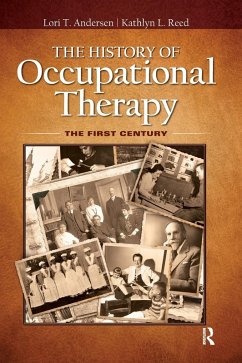- Gebundenes Buch
- Merkliste
- Auf die Merkliste
- Bewerten Bewerten
- Teilen
- Produkt teilen
- Produkterinnerung
- Produkterinnerung
To understand who we are and where we are going, we first need to understand who we were and where we came from.
Andere Kunden interessierten sich auch für
![Kinesiology for the Occupational Therapy Assistant Kinesiology for the Occupational Therapy Assistant]() Susan SainKinesiology for the Occupational Therapy Assistant122,99 €
Susan SainKinesiology for the Occupational Therapy Assistant122,99 €![A Guide to the Formulation of Plans and Goals in Occupational Therapy A Guide to the Formulation of Plans and Goals in Occupational Therapy]() Sue ParkinsonA Guide to the Formulation of Plans and Goals in Occupational Therapy197,99 €
Sue ParkinsonA Guide to the Formulation of Plans and Goals in Occupational Therapy197,99 €![Quintessential Occupational Therapy Quintessential Occupational Therapy]() Robin AkselrudQuintessential Occupational Therapy78,99 €
Robin AkselrudQuintessential Occupational Therapy78,99 €![Occupational Therapy for Adults With Intellectual Disability Occupational Therapy for Adults With Intellectual Disability]() Kimberly BryzeOccupational Therapy for Adults With Intellectual Disability97,99 €
Kimberly BryzeOccupational Therapy for Adults With Intellectual Disability97,99 €![Occupational Therapy and Spirituality Occupational Therapy and Spirituality]() Barbara HemphillOccupational Therapy and Spirituality198,99 €
Barbara HemphillOccupational Therapy and Spirituality198,99 €![Occupational Therapy Groups for Addressing Mental Health Challenges in School-Aged Populations Occupational Therapy Groups for Addressing Mental Health Challenges in School-Aged Populations]() Brad EganOccupational Therapy Groups for Addressing Mental Health Challenges in School-Aged Populations78,99 €
Brad EganOccupational Therapy Groups for Addressing Mental Health Challenges in School-Aged Populations78,99 €![Quick Reference Dictionary for Occupational Therapy Quick Reference Dictionary for Occupational Therapy]() Karen JacobsQuick Reference Dictionary for Occupational Therapy120,99 €
Karen JacobsQuick Reference Dictionary for Occupational Therapy120,99 €-
-
-
To understand who we are and where we are going, we first need to understand who we were and where we came from.
Hinweis: Dieser Artikel kann nur an eine deutsche Lieferadresse ausgeliefert werden.
Hinweis: Dieser Artikel kann nur an eine deutsche Lieferadresse ausgeliefert werden.
Produktdetails
- Produktdetails
- Verlag: Routledge
- Seitenzahl: 416
- Erscheinungstermin: 15. Januar 2017
- Englisch
- Abmessung: 260mm x 183mm x 27mm
- Gewicht: 974g
- ISBN-13: 9781617119972
- ISBN-10: 1617119970
- Artikelnr.: 55713748
- Herstellerkennzeichnung
- Libri GmbH
- Europaallee 1
- 36244 Bad Hersfeld
- gpsr@libri.de
- Verlag: Routledge
- Seitenzahl: 416
- Erscheinungstermin: 15. Januar 2017
- Englisch
- Abmessung: 260mm x 183mm x 27mm
- Gewicht: 974g
- ISBN-13: 9781617119972
- ISBN-10: 1617119970
- Artikelnr.: 55713748
- Herstellerkennzeichnung
- Libri GmbH
- Europaallee 1
- 36244 Bad Hersfeld
- gpsr@libri.de
Lori T. Andersen, EdD, OTR/L, FAOTA, received her Bachelor of Science degree in Rehabilitation Services from Springfield College, her Master of Science degree in Occupational Therapy from the Medical College of Virginia, and her Doctorate in Education from Nova Southeastern University. She has more than 15 years of experience in clinical practice and more than 20 years in academia. Her academic positions in occupational therapy have included the following: Associate Professor at Florida Gulf Coast University, Professor at Nova Southeastern University, Visiting Clinical Associate Professor at Florida International University, and Professor at Brenau University. She is now enjoying retirement, pursuing such passions as traveling and researching the history of occupational therapy. Kathlyn (Kitty) L. Reed, PhD, OTR, FAOTA, MLIS, is Associate Professor Emeritus, School of Occupational Therapy, Texas Woman's University, Houston, Texas. She completed her basic education in occupational therapy at the University of Kansas, received a master's degree in occupational therapy from Western Michigan University, obtained a doctorate in special education from the University of Washington, and was awarded a second master's in information and library studies from the University of Oklahoma. She has been active in occupational therapy for over 50 years as a practitioner, educator, and consultant. Reed has authored several textbooks in occupational therapy and co-authored textbooks in physical therapy and speech-language pathology. She was named a fellow of the American Occupational Therapy Association (AOTA) in 1975, received the AOTA Award of Merit in 1983 and presented the Eleanor Clarke Slagle lectureship at the AOTA annual conference in 1986. She has served in the AOTA Delegate and Representative Assemblies representing three different state associations and was chair of the AOTA Ethics Commission. She is a member of the Texas Occupational Therapy Association, the World Federation of Occupational Therapists and the Society for the Study of Occupation. Her interests include tracking assessments developed by occupational therapists.
Dedication Acknowledgments About the Authors Foreword by Charles H.
Christiansen, EdD, OTR, FAOTA Introduction Chapter 1 The Formative Stages:
Ancient Times to 1900s Chapter 2 Conception and Formal Birth: 1900s to 1917
Chapter 3 World War I: 1917 to 1920s Chapter 4 Standard Setting: 1920s to
1940s Chapter 5 Rapid Growth and Expansion: 1940s to 1960s Chapter 6
Turning Points: 1960s to 1970s Chapter 7 Back to Philosophical Base: 1970s
to 1980s Chapter 8 Search for a Unifying Theory: 1980s to 1990s Chapter 9
Time of Conflict: 1990s to 2000s Chapter 10 Looking to the Future: 2000s to
2010s Chapter 11 On the Road to the Centennial Vision and Beyond Appendix A
Presidents of NSPOT and AOTA Appendix B Executive Officers of NSPOT and
AOTA Appendix C Locations of Headquarters for NSPOT and AOTA Appendix D
Official Organ/Journal of NSPOT and AOTA Appendix E Annual Meetings of
NSPOT and AOTAAppendix F Eleanor Clarke Slagle Lecturers and Lectures.
Appendix G AOTA Award of Merit Recipients Appendix H AOTA Membership
Summary Index
Christiansen, EdD, OTR, FAOTA Introduction Chapter 1 The Formative Stages:
Ancient Times to 1900s Chapter 2 Conception and Formal Birth: 1900s to 1917
Chapter 3 World War I: 1917 to 1920s Chapter 4 Standard Setting: 1920s to
1940s Chapter 5 Rapid Growth and Expansion: 1940s to 1960s Chapter 6
Turning Points: 1960s to 1970s Chapter 7 Back to Philosophical Base: 1970s
to 1980s Chapter 8 Search for a Unifying Theory: 1980s to 1990s Chapter 9
Time of Conflict: 1990s to 2000s Chapter 10 Looking to the Future: 2000s to
2010s Chapter 11 On the Road to the Centennial Vision and Beyond Appendix A
Presidents of NSPOT and AOTA Appendix B Executive Officers of NSPOT and
AOTA Appendix C Locations of Headquarters for NSPOT and AOTA Appendix D
Official Organ/Journal of NSPOT and AOTA Appendix E Annual Meetings of
NSPOT and AOTAAppendix F Eleanor Clarke Slagle Lecturers and Lectures.
Appendix G AOTA Award of Merit Recipients Appendix H AOTA Membership
Summary Index
Dedication Acknowledgments About the Authors Foreword by Charles H.
Christiansen, EdD, OTR, FAOTA Introduction Chapter 1 The Formative Stages:
Ancient Times to 1900s Chapter 2 Conception and Formal Birth: 1900s to 1917
Chapter 3 World War I: 1917 to 1920s Chapter 4 Standard Setting: 1920s to
1940s Chapter 5 Rapid Growth and Expansion: 1940s to 1960s Chapter 6
Turning Points: 1960s to 1970s Chapter 7 Back to Philosophical Base: 1970s
to 1980s Chapter 8 Search for a Unifying Theory: 1980s to 1990s Chapter 9
Time of Conflict: 1990s to 2000s Chapter 10 Looking to the Future: 2000s to
2010s Chapter 11 On the Road to the Centennial Vision and Beyond Appendix A
Presidents of NSPOT and AOTA Appendix B Executive Officers of NSPOT and
AOTA Appendix C Locations of Headquarters for NSPOT and AOTA Appendix D
Official Organ/Journal of NSPOT and AOTA Appendix E Annual Meetings of
NSPOT and AOTAAppendix F Eleanor Clarke Slagle Lecturers and Lectures.
Appendix G AOTA Award of Merit Recipients Appendix H AOTA Membership
Summary Index
Christiansen, EdD, OTR, FAOTA Introduction Chapter 1 The Formative Stages:
Ancient Times to 1900s Chapter 2 Conception and Formal Birth: 1900s to 1917
Chapter 3 World War I: 1917 to 1920s Chapter 4 Standard Setting: 1920s to
1940s Chapter 5 Rapid Growth and Expansion: 1940s to 1960s Chapter 6
Turning Points: 1960s to 1970s Chapter 7 Back to Philosophical Base: 1970s
to 1980s Chapter 8 Search for a Unifying Theory: 1980s to 1990s Chapter 9
Time of Conflict: 1990s to 2000s Chapter 10 Looking to the Future: 2000s to
2010s Chapter 11 On the Road to the Centennial Vision and Beyond Appendix A
Presidents of NSPOT and AOTA Appendix B Executive Officers of NSPOT and
AOTA Appendix C Locations of Headquarters for NSPOT and AOTA Appendix D
Official Organ/Journal of NSPOT and AOTA Appendix E Annual Meetings of
NSPOT and AOTAAppendix F Eleanor Clarke Slagle Lecturers and Lectures.
Appendix G AOTA Award of Merit Recipients Appendix H AOTA Membership
Summary Index








